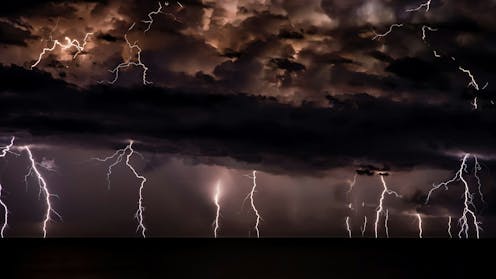Source: The Conversation – Global Perspectives – By Rick Sarre, Emeritus Professor in Law and Criminal Justice, University of South Australia
Erin Patterson, having been convicted in the Supreme Court of Victoria two months ago on three counts of murder and one count of attempted murder, has today received a life sentence from the trial judge, Justice Christopher Beale.
He ordered a non-parole period of 33 years. Given her age (50) and the 676 days she’s already spent in detention, this means Patterson will not be eligible to apply for parole until 2056, when she is in her 80s.
Erin Patterson’s story is now one of the most well-known true crime cases in Australia. Nine weeks ago, a jury found her guilty of poisoning her lunch guests in July 2023 at her home in Leongatha with foraged death-cap mushrooms she had baked into individual servings of Beef Wellington.
In sentencing, Justice Beale said he had no hesitation in finding Patterson’s offending falls into the “worst category” of murder and attempted murder.
So after months of media frenzy and myriad headlines, the sentencing now bookends the case, pending any appeal. Here’s how the judge reached his decision and what happens now.
A lengthy prison term
The life sentence was as expected, given Patterson’s lawyer, Colin Mandy, did not oppose the prosecution’s bid for the maximum sentence for murder in Victoria.
The matter that exercised the judge’s mind, principally, in considering the sentence was the length of the non-parole period. The standard such period for murder in Victoria is 20 years.
If there’s more than one victim, however, the minimum non-parole period increases to 25 years.
While it’s possible to sentence a murderer to life without parole, it is very unusual.
In 2019, the judge who gave a life sentence to James Gargasoulas, the man who drove down Bourke Street Mall in Melbourne, killing six people, set a non-parole period of 46 years.
What did the judge consider?
The factors taken into account in sentencing relate to the nature of the crime and the personal circumstances of the person convicted.
The final outcome is informed by principles that vary only slightly across Australia’s states and territories.
The main one here, arguably, was denunciation: the sentence needs to reinforce in the public mind the abhorrence of her conduct.
Indeed, there was no plea of guilty, and no remorse from Patterson at any time.
Moreover, when considering a non-parole period, a judge takes into account what is referred to as “proportionality”. This can be a limiting feature where there is lesser culpability, but an exacerbating feature where there are multiple deaths.
One might refer to it colloquially as a person receiving their “just desserts”.
In this instance, the judge was mindful of the fact there were four victims.
He was also mindful of Patterson’s “harsh” prison conditions, telling the court:
you have effectively been held in continuous solitary confinement for the last 15 months and at the very least there is a substantial chance that for your protection you will continue to be held in solitary confinement for years to come.
Deterrence, as a regular feature of the sentencing exercise, in this case becomes a companion to denunciation.
Rehabilitation was always unlikely to have any impact on the sentence, given the life term. There was no submission by defence counsel that his client had a diagnosed mental disorder or would benefit from any form of an ongoing remediation or restorative program.
Huge personal tolls
What dominated the submissions at the pre-sentence hearing in August were the victim impact statements.
In Victoria, such statements have been in place since 1994, but it has only been since 2005 that the court has been required to take account of the impact of the crime on any victim when sentencing.
Only since 2011 have victims been granted the right to read a statement aloud in court or have a nominated representative do so on their behalf.
In the Patterson pre-sentence hearing, the sole survivor of the meal, Ian Wilkinson, read his own statement and described the loss of his wife Heather. He said he felt “only half alive without her”.
Patterson’s estranged husband Simon did not attend the pre-sentence hearing, so his statement was read to the judge by a family member. His children, he wrote:
have […] been robbed of hope for the kind of relationship with their mother that every child naturally yearns for.
The Wilkinsons’ daughter, Ruth Dubois, also addressed the judge with her own statement. She highlighted the wider victims of the crimes, namely medical staff, investigators, shop owners (who had had their names scrutinised), mushroom growers, the health department and taxpayers.
“I am horrified,” she said, “that our family is even associated, through no choice of our own, with such destructive behaviour towards the community”.
Will there be an appeal?
Patterson’s counsel has 28 days in which to appeal. An appeal would either be against conviction or the sentence or both.
In relation to an appeal against conviction, defence counsel would need to establish that the trial judge made a mistake in admitting (or ruling out) certain evidence or failing to properly explain the defence case.
The former, a mistake about evidence, is the more common appeal ground.
Less likely is the latter appeal ground because it would be difficult for defence counsel to assert that his client’s case was given too little regard by the judge, given the amount of time (almost two days) Justice Beale devoted to explaining the defence case to the jury.
When appealing the length of the non-parole period, either counsel can argue the duration was either manifestly inadequate (a prosecution submission) or manifestly excessive (a defence submission). It remains to be seen if either side will pursue this option.
Whatever the case, there would not be too many observers surprised by the judge’s final determination.
![]()
The authors do not work for, consult, own shares in or receive funding from any company or organisation that would benefit from this article, and have disclosed no relevant affiliations beyond their academic appointment.
– ref. Four victims, no remorse: Erin Patterson given a life sentence for mushroom murders – https://theconversation.com/four-victims-no-remorse-erin-patterson-given-a-life-sentence-for-mushroom-murders-264128



